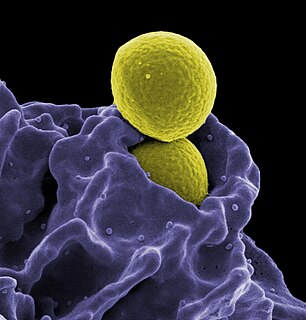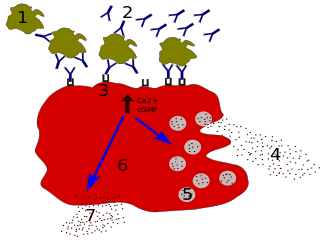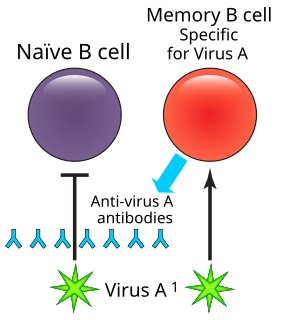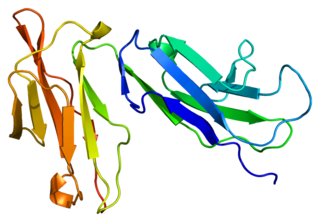Related Research Articles

An antibody (Ab), also known as an immunoglobulin (Ig), is a large, Y-shaped protein used by the immune system to identify and neutralize foreign objects such as pathogenic bacteria and viruses. The antibody recognizes a unique molecule of the pathogen, called an antigen. Each tip of the "Y" of an antibody contains a paratope that is specific for one particular epitope on an antigen, allowing these two structures to bind together with precision. Using this binding mechanism, an antibody can tag a microbe or an infected cell for attack by other parts of the immune system, or can neutralize it directly.

Immunology is a branch of biology that covers the study of immune systems in all organisms. Immunology charts, measures, and contextualizes the physiological functioning of the immune system in states of both health and diseases; malfunctions of the immune system in immunological disorders ; and the physical, chemical, and physiological characteristics of the components of the immune system in vitro, in situ, and in vivo. Immunology has applications in numerous disciplines of medicine, particularly in the fields of organ transplantation, oncology, rheumatology, virology, bacteriology, parasitology, psychiatry, and dermatology.

B cells, also known as B lymphocytes, are a type of white blood cell of the lymphocyte subtype. They function in the humoral immunity component of the adaptive immune system. B cells produce antibody molecules; however, these antibodies are not secreted. Rather, they are inserted into the plasma membrane where they serve as a part of B-cell receptors. When a naïve or memory B cell is activated by an antigen, it proliferates and differentiates into an antibody-secreting effector cell, known as a plasmablast or plasma cell. Additionally, B cells present antigens and secrete cytokines. In mammals, B cells mature in the bone marrow, which is at the core of most bones. In birds, B cells mature in the bursa of Fabricius, a lymphoid organ where they were first discovered by Chang and Glick, which is why the 'B' stands for bursa and not bone marrow as commonly believed.

Natural killer cells, also known as NK cells or large granular lymphocytes (LGL), are a type of cytotoxic lymphocyte critical to the innate immune system that belong to the rapidly expanding family of innate lymphoid cells (ILC) and represent 5–20% of all circulating lymphocytes in humans. The role of NK cells is analogous to that of cytotoxic T cells in the vertebrate adaptive immune response. NK cells provide rapid responses to virus-infected cell and other intracellular pathogens acting at around 3 days after infection, and respond to tumor formation. Typically, immune cells detect the major histocompatibility complex (MHC) presented on infected cell surfaces, triggering cytokine release, causing the death of the infected cell by lysis or apoptosis. NK cells are unique, however, as they have the ability to recognize and kill stressed cells in the absence of antibodies and MHC, allowing for a much faster immune reaction. They were named "natural killers" because of the notion that they do not require activation to kill cells that are missing "self" markers of MHC class 1. This role is especially important because harmful cells that are missing MHC I markers cannot be detected and destroyed by other immune cells, such as T lymphocyte cells.

A lymphocyte is a type of white blood cell in the immune system of jawed vertebrates. Lymphocytes include natural killer cells, T cells, and B cells. They are the main type of cell found in lymph, which prompted the name "lymphocyte".
Immunoglobulin G (IgG) is a type of antibody. Representing approximately 75% of serum antibodies in humans, IgG is the most common type of antibody found in blood circulation. IgG molecules are created and released by plasma B cells. Each IgG antibody has two paratopes.

Immunoglobulin A is an antibody that plays a crucial role in the immune function of mucous membranes. The amount of IgA produced in association with mucosal membranes is greater than all other types of antibody combined. In absolute terms, between three and five grams are secreted into the intestinal lumen each day. This represents up to 15% of total immunoglobulins produced throughout the body.

Immunoglobulin D (IgD) is an antibody isotype that makes up about 1% of proteins in the plasma membranes of immature B-lymphocytes where it is usually co-expressed with another cell surface antibody called IgM. IgD is also produced in a secreted form that is found in very small amounts in blood serum, representing 0.25% of immunoglobulins in serum. The relative molecular mass and half-life of secreted IgD is 185 kDa and 2.8 days, respectively. Secreted IgD is produced as a monomeric antibody with two heavy chains of the delta (δ) class, and two Ig light chains.

Immunoglobulin E (IgE) is a type of antibody that has been found only in mammals. IgE is synthesised by plasma cells. Monomers of IgE consist of two heavy chains and two light chains, with the ε chain containing 4 Ig-like constant domains (Cε1-Cε4). IgE is thought to be an important part of the immune response against infection by certain parasitic worms, including Schistosoma mansoni, Trichinella spiralis, and Fasciola hepatica. IgE is also utilized during immune defense against certain protozoan parasites such as Plasmodium falciparum. IgE may have evolved as a defense to protect against venoms.

In immunology, a memory B cell (MBC) is a type of B lymphocyte that forms part of the adaptive immune system. These cells develop within germinal centers of the secondary lymphoid organs. Memory B cells circulate in the blood stream in a quiescent state, sometimes for decades. Their function is to memorize the characteristics of the antigen that activated their parent B cell during initial infection such that if the memory B cell later encounters the same antigen, it triggers an accelerated and robust secondary immune response. Memory B cells have B cell receptors (BCRs) on their cell membrane, identical to the one on their parent cell, that allow them to recognize antigen and mount a specific antibody response.
Opsonins are proteins of the innate and adaptive immune system that facilitate phagocytosis and cell lysis by “marking” antigens. Opsonization, then, is the modification of antigens by opsonins to make them more accessible to phagocytic cells and other immune cells. Opsonins bind to antigen and are recognized by receptors on immune cells.

The adaptive immune system, also referred as the acquired immune system, is a subsystem of the immune system that is composed of specialized, systemic cells and processes that eliminate pathogens or prevent their growth. The acquired immune system is one of the two main immunity strategies found in vertebrates.

The marginal zone is the region at the interface between the non-lymphoid red pulp and the lymphoid white-pulp of the spleen.

An immune complex, sometimes called an antigen-antibody complex or antigen-bound antibody, is a molecule formed from the binding of multiple antigens to antibodies. The bound antigen and antibody act as a unitary object, effectively an antigen of its own with a specific epitope. After an antigen-antibody reaction, the immune complexes can be subject to any of a number of responses, including complement deposition, opsonization, phagocytosis, or processing by proteases. Red blood cells carrying CR1-receptors on their surface may bind C3b-coated immune complexes and transport them to phagocytes, mostly in liver and spleen, and return to the general circulation.

The B cell receptor (BCR) is a transmembrane protein on the surface of a B cell. B cell receptors are composed of immunoglobulin molecules that form a type 1 transmembrane receptor protein, and are typically located on the outer surface of these lymphocyte cells. Through biochemical signaling and by physically acquiring antigens from the immune synapses, the BCR controls the activation of the B cell. B cells are able to gather and grab antigens by engaging biochemical modules for receptor clustering, cell spreading, generation of pulling forces, and receptor transport, which eventually culminates in endocytosis and antigen presentation. B cells' mechanical activity adheres to a pattern of negative and positive feedbacks that regulate the quantity of removed antigen by manipulating the dynamic of BCR–antigen bonds directly. Particularly, grouping and spreading increase the relation of antigen with BCR, thereby proving sensitivity and amplification. On the other hand, pulling forces delinks the antigen from the BCR, thus testing the quality of antigen binding.

B-lymphocyte antigen CD19, also known as CD19 molecule, B-Lymphocyte Surface Antigen B4, T-Cell Surface Antigen Leu-12 and CVID3 is a transmembrane protein that in humans is encoded by the gene CD19. In humans, CD19 is expressed in all B lineage cells. Contrary to some early doubts, human plasma cells do express CD19, as confirmed by others. CD19 plays two major roles in human B cells: on the one hand, it acts as an adaptor protein to recruit cytoplasmic signaling proteins to the membrane; on the other, it works within the CD19/CD21 complex to decrease the threshold for B cell receptor signaling pathways. Due to its presence on all B cells, it is a biomarker for B lymphocyte development, lymphoma diagnosis and can be utilized as a target for leukemia immunotherapies.

In immunology, antibodies are classified into several types called isotypes or classes. The variable (V) regions near the tip of the antibody can differ from molecule to molecule in countless ways, allowing it to specifically target an antigen . In contrast, the constant (C) regions only occur in a few variants, which define the antibody's class. Antibodies of different classes activate distinct effector mechanisms in response to an antigen . They appear at different stages of an immune response, differ in structural features, and in their location around the body.

Fc fragment of IgG receptor IIb is a low affinity inhibitory receptor for the Fc region of immunoglobulin gamma (IgG). FCGR2B participates in the phagocytosis of immune complexes and in the regulation of antibody production by B lymphocytes.
Marginal zone B cells are noncirculating mature B cells that in humans segregate anatomically into the marginal zone (MZ) of the spleen and certain other types of lymphoid tissue. The MZ B cells within this region typically express low-affinity polyreactive B-cell receptors (BCR), high levels of IgM, Toll-like receptors (TLRs), CD21, CD1, CD9, CD27 with low to negligible levels of secreted-IgD, CD23, CD5, and CD11b that help to distinguish them phenotypically from follicular (FO) B cells and B1 B cells.
The immune network theory is a theory of how the adaptive immune system works, that has been developed since 1974 mainly by Niels Jerne and Geoffrey W. Hoffmann. The theory states that the immune system is an interacting network of lymphocytes and molecules that have variable (V) regions. These V regions bind not only to things that are foreign to the vertebrate, but also to other V regions within the system. The immune system is therefore seen as a network, with the components connected to each other by V-V interactions.
References
- 1 2 3 4 5 6 7 8 Cunningham AF, Flores-Langarica A, Bobat S, Medina CC, Cook CN, Ross EA, Lopez-Macias C, Henderson IR (2014). "B1b cells recognize protective antigens after natural infection and vaccination". Front Immunol. 5 (535): 379–90. doi:10.3389/fimmu.2014.00535. PMC 4215630 . PMID 25400633.
- 1 2 Alugupalli KR, Leong JM, Woodland RT, Muramatsu M, Honjo T, Gerstein RM (2004). "B1b lymphocytes confer T cell-independent long-lasting immunity". Immunity. 21 (3): 379–90. doi:10.1016/j.immuni.2004.06.019. PMID 15357949.
- ↑ Griffin DO, Holodick NE, Rothstein TL (2011). "Human B1 cells in umbilical cord and adult peripheral blood express the novel phenotype CD20+ CD27+ CD43+ CD70-". The Journal of Experimental Medicine. 208 (1): 67–80. doi:10.1084/jem.20101499. PMC 3023138 . PMID 21220451.
- ↑ Tung JW, Mrazek MD, Yang Y, Herzenberg LA, Herzenberg LA (2006). "Phenotypically distinct B cell development pathways map to the three B cell lineages in the mouse". Proceedings of the National Academy of Sciences of the United States of America. 103 (16): 6293–8. Bibcode:2006PNAS..103.6293T. doi:10.1073/pnas.0511305103. PMC 1458871 . PMID 16606838.
- ↑ Haas KM, Poe JC, Steeber DA, Tedder TF (2005). "B-1a and B-1b cells exhibit distinct developmental requirements and have unique functional roles in innate and adaptive immunity to S. pneumoniae". Immunity. 23 (1): 7–18. doi:10.1016/j.immuni.2005.04.011. PMID 16039575.
- ↑ Ghosn EE, Yang Y, Tung J, Herzenberg LA, Herzenberg LA (2008). "CD11b expression distinguishes sequential stages of peritoneal B-1 development". Proceedings of the National Academy of Sciences of the United States of America. 105 (13): 5195–200. Bibcode:2008PNAS..105.5195G. doi:10.1073/pnas.0712350105. PMC 2278228 . PMID 18375763.
- ↑ Hayakawa K, Hardy RR, Herzenberg LA, Herzenberg LA (1985). "Progenitors for Ly-1 B cells are distinct from progenitors for other B cells". The Journal of Experimental Medicine. 161 (6): 1554–68. doi:10.1084/jem.161.6.1554. PMC 2187623 . PMID 3874257.
- ↑ Lalor PA, Stall AM, Adams S, Herzenberg LA (1989). "Permanent alteration of the murine Ly-1 B repertoire due to selective depletion of Ly-1 B cells in neonatal animals". European Journal of Immunology. 19 (3): 501–6. doi:10.1002/eji.1830190314. PMID 2785045.
- 1 2 Kantor AB, Herzenberg LA (1993). "Origin of murine B cell lineages". Annual Review of Immunology. 11: 501–38. doi:10.1146/annurev.iy.11.040193.002441. PMID 8476571.
- ↑ Hayakawa K, Hardy RR, Herzenberg LA (1986). "Peritoneal Ly-1 B cells: genetic control, autoantibody production, increased lambda light chain expression". European Journal of Immunology. 16 (4): 450–6. doi:10.1002/eji.1830160423. PMID 3084283.
- ↑ Martin F, Kearney JF (2001). "B1 cells: similarities and differences with other B cell subsets". Current Opinion in Immunology. 13 (2): 195–201. doi:10.1016/S0952-7915(00)00204-1. PMID 11228413.
- ↑ Bendelac A, Bonneville M, Kearney JF (2001). "Autoreactivity by design: innate B and T lymphocytes". Nature Reviews. Immunology. 1 (3): 177–86. doi:10.1038/35105052. PMID 11905826.